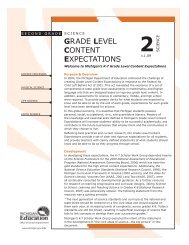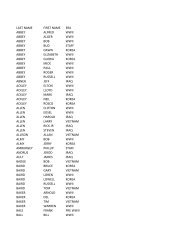Grade Level Content Expectations - State of Michigan
Grade Level Content Expectations - State of Michigan
Grade Level Content Expectations - State of Michigan
You also want an ePaper? Increase the reach of your titles
YUMPU automatically turns print PDFs into web optimized ePapers that Google loves.
GEOMETRY<br />
Understand and apply basic properties<br />
G.GS.06.01 Understand and apply basic properties <strong>of</strong> lines, angles, and triangles, including:<br />
• triangle inequality<br />
• relationships <strong>of</strong> vertical angles, complementary angles, supplementary angles<br />
• congruence <strong>of</strong> corresponding and alternate interior angles when parallel lines<br />
— are cut by a transversal, and that such congruencies imply parallel lines<br />
• locate interior and exterior angles <strong>of</strong> any triangle, and use the property that an exterior<br />
— angle <strong>of</strong> a triangle is equal to the sum <strong>of</strong> the remote (opposite) interior angles<br />
• know that the sum <strong>of</strong> the exterior angles <strong>of</strong> a convex polygon is 360º.<br />
Understand the concept <strong>of</strong> congruence and basic transformations<br />
G.GS.06.02 Understand that for polygons, congruence means corresponding sides and angles<br />
have equal measures.<br />
G.TR.06.03 Understand the basic rigid motions in the plane (reflections, rotations, translations),<br />
relate these to congruence, and apply them to solve problems.<br />
G.TR.06.04 Understand and use simple compositions <strong>of</strong> basic rigid transformations, e.g., a<br />
translation followed by a reflection.<br />
Construct geometric shapes<br />
G.SR.06.05 Use paper folding to perform basic geometric constructions <strong>of</strong> perpendicular lines,<br />
midpoints <strong>of</strong> line segments and angle bisectors; justify informally.<br />
DATA AND<br />
PROBABILITY<br />
Understand the concept <strong>of</strong> probability and solve problems<br />
D.PR.06.01 Express probabilities as fractions, decimals, or percentages between 0 and 1; know<br />
that 0 probability means an event will not occur and that probability 1 means an event will occur.<br />
D.PR.06.02 Compute probabilities <strong>of</strong> events from simple experiments with equally likely<br />
outcomes, e.g., tossing dice, flipping coins, spinning spinners, by listing all possibilities and finding<br />
the fraction that meets given conditions.<br />
M I C H I G A N D E P A R T M E N T O F E D U C A T I O N ■ v. 1 2 . 0 5 ■ M A T H E M A T I C S S I X T H G R A D E 5






